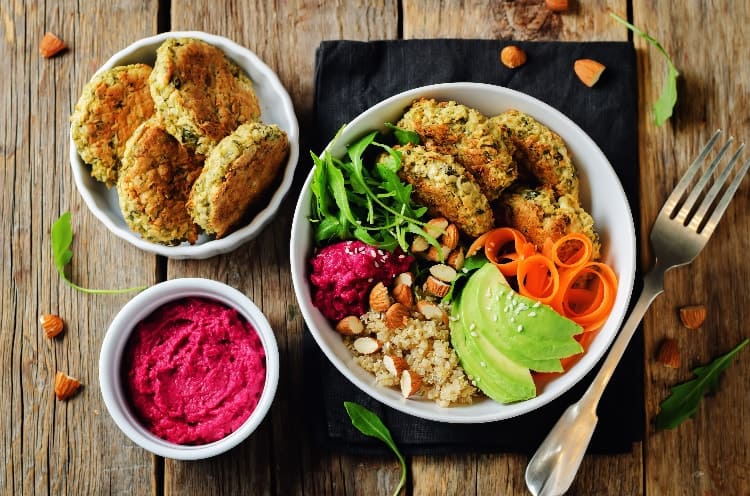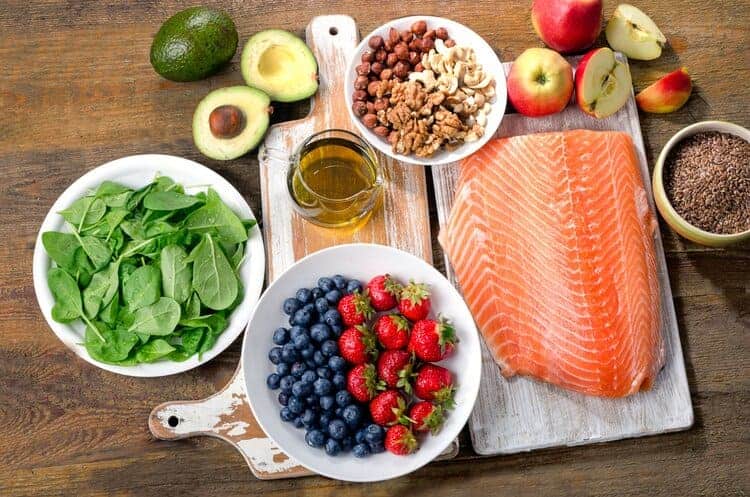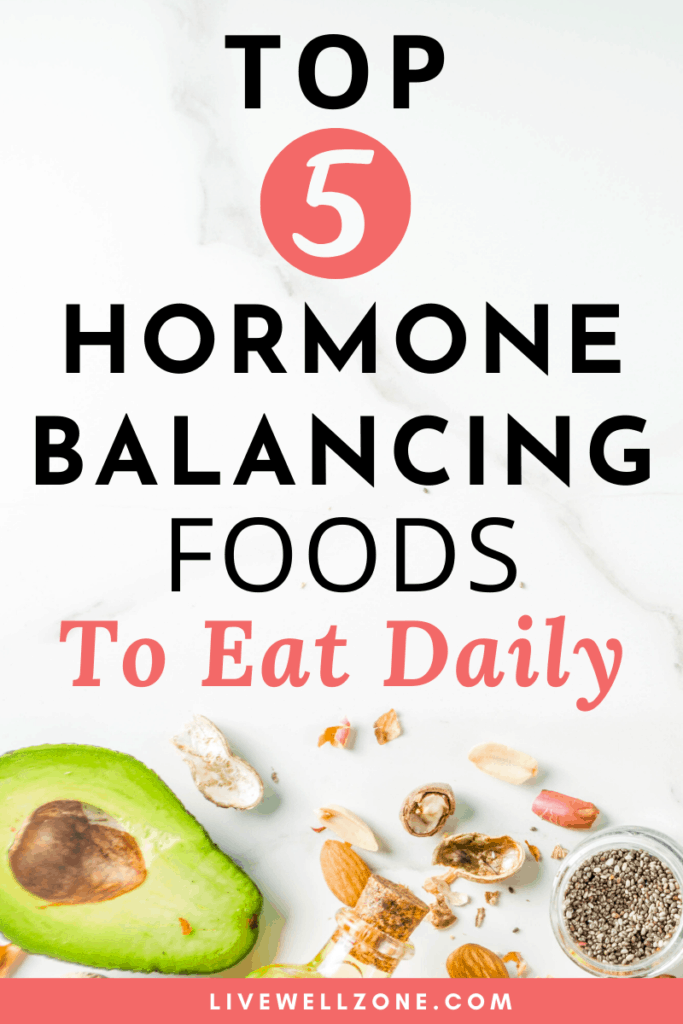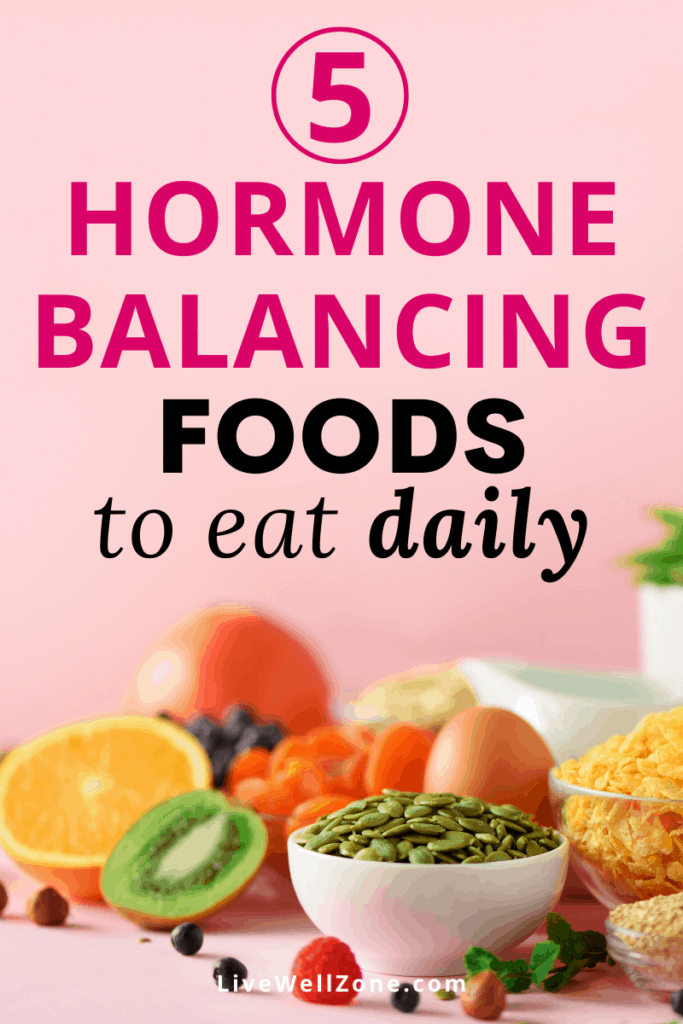
Having long-term control over your health and particularly, your hormones, starts with having a nutrient-rich diet. Just by making a few strategic food choices, you can maximize every bite you take throughout the day, to ensure that it’s working for you, rather than against you.
So in this article we’re going to look at the top 5 hormone-balancing foods to eat daily (or at least every other day if you want to ease into it!).
Now, just so we’re clear, these are not the only foods that support hormone health.
But, these pack a serious nutritional punch and therefore, they should be a top priority if want to start feeling better faster.
So, let’s dive in right in!
WHAT FOODS HELP BALANCE HORMONES?

1. Cruciferous Vegetables
From unfiltered water and pesticides to plastics and birth control…we are constantly exposed to synthetic estrogen.
All of this contributes to excess estrogen/estrogen dominance and increased toxicity.
And one of the best ways to counteract excess estrogen is to eat more cruciferous veggies.
These veggies contain glucosinolates, which are sulfur-based compounds that support the liver and make it easier to get rid of excess estrogen and other toxins.
In addition, crucifers contain a lot of fiber, which helps a lot in populating the gut (another hormone production center) with healthy bacteria.
Choose from these cruciferous veggies:
| kale | arugula |
| cauliflower | bok choy |
| broccoli | collard greens |
| cabbage | radishes |
| brussel sprouts | horseradish |
| watercress | mustard greens |
| rutabaga | turnips |
Do keep in mind that if you have thyroid issues, it’s generally recommended that you eat cruciferous veggies in cooked form: steamed, sauteed, roasted or boiled.
This is because these veggies contain goitrogens, which can interfere with the thyroid’s ability to absorb iodine.
Cooking reduces the amount of goitrogens that your body absorbs.
But just make sure to not overcook them because that can also kill essential nutrients.
A good way to test whether you’ve overcooked them or not is through the crunch. If they have some crunch you’re good. If they’re soft and lifeless, then they’re likely overdone.
2. Anti-inflammatory Proteins
No matter what type of hormonal imbalance you’re struggling with, chronic inflammation can be an underlying cause.
And one of the major contributors to inflammation are red meat and processed meats (source).
Not only are meats harder to digest than plants, but many animals are given antibiotics, growth hormones and genetically modified soy. All of these can ruin your gut and keep you in a vicious cycle of struggle.
As for foods like fish, they’re usually healthier than meat…unless they’re farm-raised. In which case, they can contribute to inflammation due to the presence of toxins.
So, focusing on anti-inflammatory proteins – mainly plant proteins, fatty fish and eggs – gives your body a chance to rest and recover.
Here are some anti-inflammatory proteins that are ideal for supporting hormone balance:
| Red beans | Peas |
| Black beans | Quinoa |
| Navy beans | Broccoli |
| Pinto beans | Nuts |
| Chickpeas | Seeds |
| Lentils | Wild rice |
| Millet | Salmon (wild caught) |
| Sardines (wild caught) | Mackerel (wild caught) |
| Organic Eggs | Tuna (wild caught) |
Now, before we wrap up this section, let’s have a quick look at soy.
Soy is a good source of plant protein. However, there’s concern that its phytoestrogen content can contribute to estrogen imbalance.
So, here are some tips to keep in mind if you’re going to consume soy:
- Consume mainly fermented soy. Fermented soy is what most Asian cultures consume and that seems to contribute to its health benefits. Fermented soy products to choose from are tamari sauce, tempeh and natto.
- Buy organic soy. Most of the soy in the U.S. is GMO soy. GMO soy plants are very resistant to pesticides. This means they can be sprayed with way more pesticides, which means we get more pesticide residue when we eat them. Unfortunately, pesticides are estrogen-based compounds, so they contribute to hormone imbalance. Therefore if you’re going to eat soy, go for organic soy.


3. Healthy Fats
Fats are the raw material for:
- estrogens
- corticosteroids (hormones produced by the adrenal glands)
- progestagens (such as progesterone)
- androgens (male hormones like testosterone and DHEA)
Without enough healthy, natural fat in your diet, your body is basically starved of the raw material that it needs to make all of those hormones.
So, it’s important to eat healthy fats on the regular.
Here are some to choose from:
| Avocados | Palm oil |
| Coconuts | Avocado oil |
| Olives | Olive Oil |
| Grapeseed oil | Macadamia nut oil |
| Sesame oil | Walnut Oil |
| Hemp seed oil | Coconut oil |
| Butter (organic) | Eggs (organic, pasture-raised) |
4. Antioxidant-Rich Fruits
Antioxidants help the body fight off the damaging effects of inflammation.
And fruits are one of the best (though not the only) sources of antioxidants.
Now, technically speaking all fruits contain antioxidants.
So, you really can’t go wrong with any fruit as long as it’s whole and unprocessed fruit.
And each fruit has different antioxidants.
Therefore, you want to eat a variety of fruits to ensure that you’re getting the benefits of everything that’s available in nature.
Here are some antioxidant-rich fruits to choose from:
| Apricots | Blackberries |
| Melons | Oranges |
| Blueberries | Apples |
| Bananas | Sweet cherries |
| Raspberries | Plums |
| Strawberries | Grapes |
| Cranberries | Peaches |
| Figs | Pears |
| Papayas | Pineapples |
| Mangoes | Kiwi |
5. Leafy Green Vegetables
According to the CDC (Centers for Disease Control and Prevention) only 10% of surveyed adults in the U.S. met the daily vegetable intake recommendations (source).
Said another way, 90% of American adults are most likely not eating the recommended amount of vegetables.
While eating any veggies is a step in the right direction, I personally like to focus more on leafy greens because they come with a laundry list of health benefits.
For example, leafy greens are:
- Gut friendly: leafy greens are loaded with a sugar called sulfoquinovose (SQ) that our bacteria feed on, resulting in more “good” bacteria (source).
- Rich in vitamin E: this vitamin has antioxidant properties and has been studied for its positive effects on hot flashes (1, 2).
- Nutrient-dense: dark leafy greens are rich in vitamins and minerals that play a role in hormone balance, including magnesium, vitamin K, vitamin C.
- Cortisol-lowering: thanks to ingredients like magnesium, dark leafy greens are helpful for lowering cortisol (source).
- Antioxidant-rich: leafy greens – whether dark or not – are a very good source of antioxidants. Not only are these antioxidants important for overall health, they may even protect the body from Non-Alcoholic Fatty Liver Disease (source). This is a type of fatty liver disease that tends to be present in women with hormonal imbalances (you can learn more in this guide on liver health and hormone balance).
And if all that isn’t enough, some leafy greens – like kale, collard and cabbage – are also cruciferous vegetables.
As we saw earlier, cruciferous vegetables contain compounds that support estrogen metabolism. Double win!
So, it’s a dark green or a light green, eating more leafy greens will keep your hormones happy.
Here are some green vegetables to consider adding to your hormone balance grocery list:
| Kale | Spinach |
| Arugula | Celery |
| Collard greens | Dandelion greens |
| Broccoli | Beet greens |
| Bok Choy | Radish greens |
| Mustard green | Romaine lettuce |
| Cabbage | Microgreens |
| Green bell peppers | Swiss chard |
WHAT NOT TO EAT WHEN BALANCING HORMONES
Pro-inflammatory foods can have a negative impact on the gut, liver, digestive system and other parts of the body that play a role in hormone balance. Therefore it’s best to avoid them.
Pro-inflammatory foods include:
- Alcohol (including wine).
- All processed foods.
- Coffee (although coffee isn’t inherently bad, it can overstimulate the adrenals for some people).
- Pasteurized juices.
- Refined carbs (such as white bread and most desserts or pastries).
- Sweetened drinks.
- Red meat and processed meats
- Hydrogenated fats (such as margarine).
- Unfermented dairy.
- Fried foods.
- Plant milks that have added sugar, artificial flavors and thickeners.
- Gluten-containing foods (especially wheat-based).
- Refined sugar.
CONCLUSION
Balancing your hormones through diet is about consistency and commitment.
By incorporating the food categories listed above into your daily routine, you’ll be building healthy habits that will pay off in the short-term and long-term.
To get started, use this hormone balance diet guide.
And for more helpful tips and ideas, be sure to check out these additional resources:
Related Articles:
Low Carb Diets and Hormones: What You Probably Don’t Know
Easy Breakfast Ideas for Balancing Hormones
5 Tips To Balance Hormones and Start Feeling Better (in as little as a week!
Exercise for Hormone Balance: A Complete Guide
Hormone Balancing Foods for PCOS: A Complete Guide (with PDF)
3-Ingredient Hormone Balancing Tea Recipe For Women
Juicing For Hormone Imbalance: A Complete Guide for Beginners
The Beginner’s Guide to Natural Hormone Balance: 8 Essential Tips


It’s was very informative.
Thank you. Glad it’s helpful 🙂
This is amazingly helpful, will give it a try😊thanks
I totally agree with this article! I had a lot of pain during my periods and gut issues. I changed my diet by cutting sugar and now eat a 90% vegan based diet. This really has changed my life. My period used to last 7 days but after 3 months I now have a 5 day period, my pain has decreased by about 70% and I just feel so much better. I hope many will stop and read this very informative article!